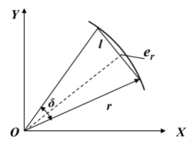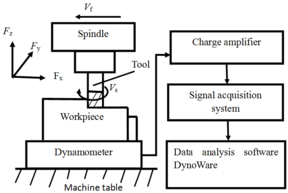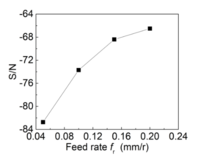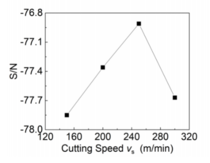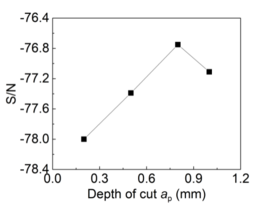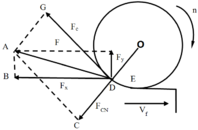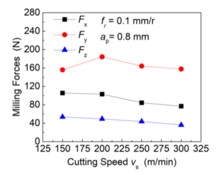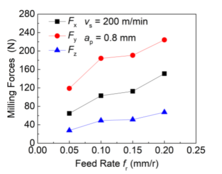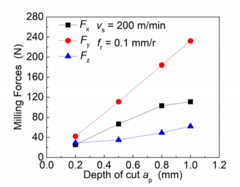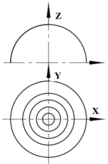Abstract: Saving energy and low carbon strategy has becoming the future trend of manufacturing industry. Cutting process in mechanical manufacturing has the characteristics of heavy energy consumption and complex process. The estimation and evaluation of energy consumption and energy efficiency of cutting process are hot topics in research groups and industry. The energy consumption of cutting process is determined by the load, which is related to the cutting parameters under fixed cutting systems, while the cutting parameter might change with the cutting process and material. Based on the relationship between energy consumption and cutting characteristics and the quality requirements, the cutting specific energy u(t) = P(t)/M(t), which is varies with time is proposed to evaluate the energy consumption of various cutting parameters under complex machining processes. The influence of cutting parameters on cutting energy consumption is studied by experiments and a calculation method is proposed to calculate cutting energy consumption. Finally, a case study of complex curve machining in mold manufacturing is illustrated to prove the effectiveness of the proposed evaluation method.
| Corresponding author. E-mail: zhanyouji@163.com; |
1. Introduction
The energy yearbook published by the U.S. energy information administration in 2012 showed that industrial electricity consumption accounted for 31% of the total electricity consumption, manufacturing electricity consumption accounted for 90% of the industrial electricity consumption, and machine tools electricity consumption occupied 75% of manufacturing electricity consumption [1]. For the reason, the energy consumption of the manufacturing industry has been widely concerned by the industry and academia. The United States Department of Energy has launched an Industrial Assessment Center program to improve the energy efficiency of manufacturing processes. Professor Gutowski at the Massachusetts Institute of Technology studied the energy consumption of various manufacturing processes on the job shop from a thermodynamic point and proposed a generalized energy flow of manufacturing system, in which machinery manufacturing is one of the important contents [2]. Peng analyzed the composition of cutting energy consumption from the perspective of mechanical mechanics, and analyzed the influence of cutting parameters on cutting power from the deduced cutting power formula[3]. Wang collects experimental data of surface roughness, cutting force and power through instruments, performs multi-objective optimization based on weighted gray correlation and least squares fitting methods, and establishes a multi-objective prediction model [4]. Xie analyzes the energy consumption characteristics at different periods of the machining process, and obtains the coefficients of the energy consumptioncutting parameter model; then constructs the univariate influence characteristic curve and multivariate influence characteristic surface of each cutting parameter according to the cutting processing conditions; finally, the processing conditions Lower cutting parameters for energy saving decisions [5-6]. Mori proposed to improve some functions of machine tools, which can reduce the energy consumption of machine tool in cutting process [7]. Qiu analyzed the cutting energy consumption and proposed a cutting energy consumption prediction model based on the exponential model and the specific cutting force model[8]. Gu established a machine tool energy consumption prediction model based on improved fruit fly algorithm and neural network integration with processing parameters as input, which can more accurately and stably predict the energy consumption of machine tools during machining[9]. Sun proposed a plunge milling tool path generation method which could control the radial depth to improve the cutting efficiency and cutter life [10]. Li proposed cutting tools energy consumption base on material extraction, manufacturing, use, and recycling [11]. Marius Winter proposed a method for reducing cutting fluid and energy consumption [12]. Study the energy consumption of the machine tool spindle during startup and operation [13]. The International Organization drafted the standard “environmental evaluation of machine tools” in 2010(ISO14955-1, 2014). And the International Organization for Standardization had revised the standard “environmental evaluation of machine tools” in 2017 (ISO 14955-1:2017) [14]. The energy consumption of manufacturing system or flexible manufacturing system is further studied [15-18].
Scholars naturally study energy efficiency while investigating energy consumption. In the aspect of energy efficiency evaluation, the scholars use the physical concept “specific energy” to scale the energy efficiency of the machine, that is, specific energy consumption (SEC). It represents the power consumed for removing unit volume material. Patrik et al apply an interdisciplinary perspective to study industrial system energy efficiency [19]. Liu et al put forward the development trend of energy efficiency of mechanical processing system [20]. Zhang analyzed energy efficiency techniques in the domain of discrete part manufacturing by reviewing [21]. Production decisions consider energy efficiency [22]. The energy efficiency of machine tool and production system was discussed hierarchically [23]. Real time power consumption monitoring to improve energy efficiency was presented [24]. Effects of tool geometry and cutting parameters on energy efficiency during turning of ANSI 4140 steel were investigated [25]. Through the study of effects of the sawing parameters on sawing force and energy consumption, Huang proved that increasing the grain depth of cutting is conducive to improve the ratio of volume crushing, thus reduce the sawing specific energy [26]. Rodrigues studied the relationship between the SEC and cutting speed and tool geometry angle in the condition of high speed cutting [27]. On the basis of a large amount of collected data, Gutowski established averaged SEC diagrams based on the materials for a variety of technology [28].
The SEC mentioned above can be a factor on its impact or the average value of the whole cutting energy consumption divided by removed material. The change of SEC caused by the change of cutting parameters to guarantee the quality in the complex process is not considered. That is to say, the time characteristic of energy consumption is not considered in the cutting process. Energy consumption is a function of time in the cutting process. For the reason, in this paper, based on the change of cutting parameters with time, the energy efficiency evaluation method of cutting technology of variable cutting parameters is proposed. Based on the experimental study of the influence of the cutting parameters on the energy consumption and the cutting quality, a method for evaluating the energy consumption of complex machining is proposed.
2. Energy consumption analysis of cutting process
2.1. Energy consumption of cutting process
The energy consumption of the cutting process is mainly composed of three parts.
(1) P1 is the power required for spindle and servo axis when the machine tool is smooth running with no-load as well as the power required for the cooling liquid(cutting fluid), air compressor, spindle cooling equipment, chip conveyor and peripheral devices such as the controller unit, etc.
(2) P2 is the power consumed by the spindle and servo axis to overcome the load in the cutting process.
(3) P3 is the power required by positioning of machine tool and acceleration/deceleration of spindle.
So the energy consumption of the cutting process E can be calculated by the formula (1)
|
(1) |
Where T1 is the no-load running time of machine tool, T2 is the cutting time, T3 is the time of positioning of machine tool and acceleration/deceleration of spindle, P1 and P3 are determined by the characteristics of the machine itself and is not affected by the cutting process. They are only related to the use time of the machine tool. Cutting power P2 changes with the cutting load, so it is important and difficult for cutting energy consumption evaluation.
2.2. Factors affecting P2 of cutting power
Cutting power is the power consumed in the cutting process, the product of the cutting force and cutting speed on the basic point of cutting edge point at the same moment. The power consumption of the feed motion is negligible compared with the power consumption of the main cutting force Fc. Thus, cutting power P2=Fc×Vs. Namely, the cutting power is determined by the main cutting force Fc and the cutting speed Vs. The main cutting force is determined by the cutting parameters. Taking the milling process as an example, the empirical formula for calculating the main cutting force is as follows:
|
(2) |
Where KFc is the influence factor related to the workpiece material and tool material, and its value is related to the experimental conditions, b1 is the influence index of the milling depth ap on the cutting force, b2 is the influence index of cutting speed Vs on the cutting force, b3 is the influence index of the feed per tooth Fz(mm/z) on the cutting force, b4 is the influence index of the milling width ae on the cutting force. From the formula (2) can be known, main cutting force Fc is determined by cutting parameters (cutting speed Vs, milling depth ap, feed per tooth Fz, milling width ae). So, the cutting power is affected by the cutting parameters. However, the choice of cutting parameters is usually determined by the machining process and the quality. Taking the surface roughness as an example, it is not only related to the cutting parameters but also to the shape of the machining surface. Under normal conditions, increasing the cutting speed can reduce the surface roughness value. The cutting depth has little influence on the surface roughness. The feed rate which has a direct relation with the residual area has a great influence on the surface roughness. The relationship between the shape of the machining surface and the surface roughness is shown in Figure 1.
The curvature of approximating arc is directly related to the residual height. The smaller the radius of curvature is, the greater the residual height is. The relationship between the residual heighter, the feed rate and the curvature is shown in Figure 1 and formula (3). For example, for the complex machining surfaces shown in Figure 2, the processing parameters must be different to ensure the four different curvature surface AB、BC、CD、CE have the same surface roughness. So the process is very complex.
|
(3) |
Where f (mm/min)is the feed rate, T is interpolation period, r is radius of curvature,l is the length of an interpolation. l=fT.
All figures and tables should be cited in the main text as Figure 1, Table 1, etc.
In summary, evaluating consumption is an evaluation of the complex process. In the process of A to E, the cutting parameters should be changed with the processing track. The change of cutting parameters will affect the cutting power P2. Obviously, this cutting power P(t) is a function of cutting time. And the material removal rate (MRR) M(t) determined by the cutting parameters is also a function of the time. So, the evaluation of cutting energy consumption under the condition of complex process should be the evaluation of energy consumption due to the change of cutting parameters with time. In the process of cutting energy consumption evaluation under complex conditions, the dynamic change of energy consumption due to the change of cutting parameters with time should be taken into full consideration.
2.3. Energy consumption evaluation function of complex process of variable cutting parameter
The analysis 2.2 shows that the cutting power and the MRR are the function of the processing time. The traditional SEC is the power consumed by removing the unit volume material. It is difficult to use it to describe the dynamic energy efficiency of cutting process. Therefore, combined with the process requirements of the cutting, this paper proposes to use power consumption by removing the unit volume material in the unit time to describe the energy efficiency. Namely:
|
(4) |
Considering the influence of the processing quality, the specific energy of the variable cutting parameters can be expressed by formula (5).
|
(5) |
Where P(t) is the time-varying cutting power. M(t) (mm3/min)is the time-varying material removal per unit time. u(t) is the time-varying cutting special energy. Q is a quality function. Qmin is the lower limit of the processing quality allowed. Qmax is the upper limit of the processing quality allowed.
With the formula (5), integral u(t)M(t) in temporal domains and the energy consumption function of the complex process of variable cutting parameter is obtained.
|
(6) |
3. Effects of different cutting parameters on the SEC
Known from 2.2, because of different cutting parameters, energy consumption MRR and surface roughness in the cutting process are changed, then cutting power and MRR can be obtained by experiments, and the corresponding cutting specific energy can be calculated.
3.1. Experimental apparatus and method
Milling experiments were conducted on a DMG DMU60 5-axes machining center (maximal spindle speed, 25000rpm; maximal feed speed, 7.6m/min). The cutters were tungsten carbide 2-flute straight end mills with TiN coating. They had a diameter of 16mm, a helix angle of 35°and a rake angle of 0°. The workpiece material used for milling was a typical S136 die steel. Figure 3 is the schematic diagram for milling experiment setup. The workpiece was mounted on a piezoelectric platform dynamometer (Kistler 9257B), with which the cutting forces (Fx, Fy, Fz) were measured during the milling process.
For the selection of milling parameters, considering machine tools, such as machine tool does not produce vibration, using recommended parameters, the orthogonal experiment of four factors was designed. In the respect of experimental design, considering the characteristics of machine tools such as stiffness and vibration of machine tool, and milling parameters allowed or recommended, the orthogonal text of four factors was designed. The experimental factors are milling speed Vs (m/min), milling depth ap (mm) and feed rate fr (mm/r). The milling width ae (mm) is unchanged and every factor has four levels. The experimental parameters and results are shown in table 1.
| No. | Vs
(m/min) |
fr
(mm/r) |
ap
(mm) |
ae
(mm) |
Ra
|
Cutting force
Fc (N) |
Milling power
Pc (w) |
Material removal rate
MRR(cm3/min) |
Cutting specific energy
u(J/mm3) |
| 1 | 150 | 0.05 | 0.2 | 12 | 0.53 | 34.46 | 86.15 | 0.36 | 14.358 |
| 2 | 150 | 0.1 | 0.5 | 12 | 0.76 | 117.00 | 292.51 | 1.79 | 9.805 |
| 3 | 150 | 0.15 | 0.8 | 12 | 1.08 | 216.33 | 540.82 | 4.30 | 7.546 |
| 4 | 150 | 0.2 | 1 | 12 | 1.23 | 295.68 | 739.21 | 7.16 | 6.194 |
| 5 | 200 | 0.05 | 0.5 | 12 | 0.42 | 80.64 | 268.82 | 1.19 | 13.554 |
| 6 | 200 | 0.1 | 0.2 | 12 | 0.67 | 47.04 | 156.82 | 0.95 | 9.904 |
| 7 | 200 | 0.15 | 1 | 12 | 1.45 | 259.29 | 864.31 | 7.16 | 7.243 |
| 8 | 200 | 0.2 | 0.8 | 12 | 1.66 | 254.86 | 849.55 | 7.64 | 6.672 |
| 9 | 250 | 0.05 | 0.8 | 12 | 0.507 | 120.03 | 500.13 | 2.39 | 12.556 |
| 10 | 250 | 0.1 | 1 | 12 | 1.12 | 235.15 | 979.78 | 5.97 | 9.847 |
| 11 | 250 | 0.15 | 0.2 | 12 | 0.828 | 61.90 | 257.91 | 1.79 | 8.645 |
| 12 | 250 | 0.2 | 0.5 | 12 | 1.11 | 179.28 | 747.00 | 5.97 | 7.508 |
| 13 | 300 | 0.05 | 1 | 12 | 0.66 | 166.75 | 833.73 | 3.58 | 13.973 |
| 14 | 300 | 0.1 | 0.8 | 12 | 0.51 | 171.82 | 859.10 | 5.73 | 8.996 |
| 15 | 300 | 0.15 | 0.5 | 12 | 0.68 | 141.46 | 707.32 | 5.37 | 7.903 |
| 16 | 300 | 0.2 | 0.2 | 12 | 0.88 | 114.61 | 573.07 | 2.86 | 12.022 |
3.2 Effects of different cutting parameters on the SEC
The experimental results show that the milling power range under different cutting parameters from 86.15 to 979.78W. The material removal rate varied from 0.36 to 7.64 cm3/min. The surface roughness varied from0.42 to 1.66μm. The cutting specific energy ranging from 6.194 to 14.358 J/mm3. From the point of reducing the energy consumption, in the premise of ensuring the quality of processing, it is hoped to consume less energy to remove the materials, that is, the SEC can be small.
The influence of the cutting parameters on the cutting specific energy can be analyzed by the Taguchi method to obtain the cutting parameters that have the minimum effect. The quality loss ( signal-to-noise ratio(S/N) ) of u(t) is calculated.
|
(7) |
To minimize the squared deviation of u(t) (or minimize the quality loss), the larger the S/N is, the better. As shown in Figure 4 to Figure 6 show the impact of speed vs, milling depth ap and feed per revolution fr on u(t).
Ultimately, the effect of cutting parameters on the cutting power is the influence on the cutting force. The total cutting force F produced by milling on the workpiece can be decomposed into the Fc along the cutting speed direction, the vertical cutting force FcN along the radial direction of the milling cutter and the back force Fp along the milling tool axis. The power consumed by Fc is called cutting power Pc .The Fp does not consumed power. In the real measurement, the force F is decompose into the feed force Fx and Fy in the vertical and back force Fp.
|
(7) |
Because the ∠BDC is determined, the ∠ADG is related to tan-1(Fy/Fx) . The larger Fy/Fx is, the smaller the ∠ADG , then the larger Fc is, the larger the cutting power at the same cutting speed. So the factors that cause the increase of the Fc will cause the increase of Fc, and Pc will increase. The relationship between the cutting parameters and the cutting force is shown in Figure 8 and Figure 10.
Figure 8. Effect of milling speed on the milling force Figure 9. Effect of the amount of feed on the milling force
The influence of the cutting parameters on the cutting forces can explain the influence of the cutting parameters on the S/N. In the Figure 4, S/N increase with the increase of Vs. But when Vs>250m/min, the S/N began to decrease. The influence of Vs on the cutting force is shown in Figure 8. Fx decrease with the increase of Vs. But the slop of the curve become smaller when Vs>250m/min, that means the decrease of Fx is not obvious. The milling force Fy almost does not change when the cutting speed increase from 150m/min to 200m/min, but in the process of 200m/min to 300m/min, it decreases with the increase of the cutting speed, and the slope of the curve become smaller when Vs>250m/min,that is, the Fy decrease of is not obvious. Because of Pc=Fc·Vs, when Vs<250m/min, the impact on S/N by decrease of Fy and Fx is larger than by increase of Vs. When the thickness of the cutting layer increases, the average deformation decreases, and the cutting force is increased, as shown in Figure10. In Figure 6, when the milling depth increases, the S/N increases and then decrease. When the milling depth increases, the cutting depth does not change and the cutting layer width increases, then the cutting load on the cutting edge, that is, the deformation resistance of cutting and friction force on the rake face is proportional to the increase. From Figure 10, with the increase of ap, the Fy increases proportionally and the Fx increases almost proportionally in the beginning, but when ap>0.8mm, the slope of Fx decreases, tan-1(Fy/Fx) and Fc increase, so the Pc increases. In a word, the S/N reduces when the ap increases, but S/N increases when the ap is larger than a certain value as shown in Figure 6.
From the above analysis and experimental results show that the cutting power and material removal rate are not same with the different cutting parameters. From the point of view of energy consumption, in the premise of satisfying the processing quality, the energy efficiency can be evaluated by the formula(5), and the energy consumption of the cutting process can be evaluated by the formula(6).
4. Energy consumption evaluation and example of complex process
As shown in Figure 11 of the processing hemisphere, the material is the same as the 2.1 experimental materials. Smooth surface with no sharp corners and pits is required. With the increase of the arc radius in the process, the cutting parameter, the unit power and the material removal amount in unit time will change with the change of the trajectory. The energy consumption of the whole process can be obtained from the formula (6). Considering the cutting force, tool life, surface quality and stability, according to the above experimental results, the value of Vs is equal to 250m/min. The every radial width of milling is equal.
According to the above experiments, the different cutting parameters correspond to the different cutting energy. Therefore, in the process of design, the cutting parameters can be used to determine the SEC and material removal, and then the energy consumption can be estimated. That is, under condition of known the SEC, based on the formula (5), integrated u(t)M(t) in the time domain to obtain the energy consumption evaluation function of variable cutting parameters under the constraint of quality, as shown in formula(7).
By formula (6):
|
(10) |
Total energy of processing semicircle:
|
(11) |
Where n is the total number of processing steps. u(ti) is a better specific energy of processing different radius circles. M(ti) is the material removal rate of processing different radius circle.
Make the angle increment between processing point and Z axis 1 degree. The machine tool is ¢10 ball cutter. Then the formula (10) can be written:
|
(12) |
As shown in Figure 11 of the hemisphere, when the machining allowance is 1mm, surface roughness Ra≤3.2 and the degree between processing point and the Z axis is in 0~10º,10º~20º,20º~30º ,30~40º,40º~60º,60º~90º, different feed speed is used to ensure the processing quality. The energy consumption calculated by formula (10) is about 7,500 kilojoule.
5.Conclusions
At present, the research on cutting process of energy still remain in the concept of static macro, such as the energy flow of manufacturing system, the proportion of the cutting energy consumption in the entire system and the composition of energy consumption of machine tool. Cutting process is a complicated process because the cutting power is determined by the load, the load is determined by the cutting parameters in the machining process system. During the cutting process, cutting parameters will change with the change of processing elements. In order to guarantee the machining quality, selection of cutting parameters should change with process and processing factors. In the process of cutting energy consumption under complex conditions, the dynamic change of energy consumption due to the change of cutting parameters with time should be taken into full consideration. Studying on machining efficiency is to seek the minimum energy consumption or the maximum material removal per unit time under the condition of quality assurance. So it is proposed to evaluate the energy consumption of the complex machining process with the specific energy u(t) = P(t)/M(t). Because the evaluation index considers the actual situation during the cutting process, it can reflect the energy consumption of complex process of variable cutting parameters which makes it possible that energy consumption becomes a factor to be considered in computer aided process design. It also provides the basis for the energy consumption to be one of the conditions for choosing the cutting parameters in the design of adaptive system for cutting machine tools.
Acknowledgments
The authors would like to gratefully acknowledge the financial support of the National Natural Science Foundation of China (Grant No. 51775113).
References
[1] EIA,2011.Annual EnergyReview. http://www.eia.gov/totalenergy/data/annual/index.cfm. Last visited: March 2018.
[2] Gutowski TG, Branham MS, Dahmus JB, Jones AJ, Thiriez A (2009) Thermodynamic analysis of resources used in manufacturing processes. Environ Sci Technol 43: 1584-1590.
[3] Peng Lei, Lu Yan (2020) Analysis of the influence of key factors of cutting energy consumption under the cutting state of CNC machine tools[J]. Forging Equipment and Manufacturing Technology, 2020, 55(04): 111-115(in Chinese).
[4] Wang Jinfeng, Pan Lijuan, Xing Dixiong, Ding Haimin(2020) Multi-objective optimization of SiCp/Al composite cutting parameters based on energy consumption efficiency[J]. Journal of Central South University (Natural Science Edition), 2020, 51(06): 1565-1574(in Chinese).
[5] Xie Jun, Ma Jinghua, Luo Xiao(2020) Research on energy-saving optimization-oriented machine tool energy consumption model and cutting parameter decision-making method[J]. Journal of Chongqing University of Technology (Natural Science), 2020, 34(08): 77-86.
[6] Lv JX, Tang RZ, Jia S, Liu Y (2016) Experimental study on energy consumption of computer numerical control machine tools. J Clean Prod 112: 3864-3874. doi: 10.1016/j.jclepro.2015.07.040.
[7] Mori M, Fujishima M, Inamasu Y, Oda Y (2011) A study on energy efficiency improvement for machine tools. CIRP Ann - Manuf Technol 60: 145-148. doi: 10.1016/j.cirp.2011.03.099.
[8] Qiu Xing (2016) Research on Prediction Method of Cutting Energy Consumption in Workpiece Machining Process and Development of Application System. J Chongqing Univ 13(2): 8-14(in Chinese).
[9] Gu Wen, Xu ZJ (1990) Prediction of machine tool energy consumption based on neural network integration and fruit fly algorithm. D Huazhong University of Science and Technology (in Chinese).
[10] Sun C, Wang YH, Huang ND (2015) A new plunge milling tool path generation method for radial depth control using medial axis transform. Int J Adv Manuf Technol 76: 1575-1582. doi: 10.1007/s00170-014-6375-5.
[11] Li BJ, Cao HJ, YAN JH. Jafar S (2017) A life cycle approach to characterizing carbon efficiency of cutting tools. Int J Adv Manuf Technol 93: 3347-3355. doi: 10.1007/s00170-017-0728-9.
[12] Winter M, Thiede S, Herrmann C (2015) Influence of the cutting fluid on process energy demand and surface roughness in grinding–a technological, environmental and economic examination. Int J Adv Manuf Technol 77: 2005-2017. doi: 10.1007/s00170-014-6557-1.
[13] Wójcicki J, Bianchi G (2018) Electric load management in spindle run-up and run-down for multi-spindle machine tools via optimal power-torque trajectories and peak load synchronization. Int J Adv Manuf Technol 95: 1819-1835. doi:10.1007/s00170-017-1341-7
[14] https://www.iso.org/standard/55294.html. Last visited: March 2018.
[15] Nancy D, David D (2012) Cost and Energy Consumption Optimization of Product Manufacture in a Flexible Manufacturing System. Proceedings of 19th CIRP International Conference on Life Cycle Engineering, Berkeley 411-416.
[16] Wang XL, Luo W, Zhang H, Dan BB, Li Fei (2016) Energy consumption model and its simulation for manufacturing and remanufacturing systems. Int J Adv Manuf Technol 87: 1557-1569. doi: 10.1007/s00170-015-7057-7.
[17] Seow Y, Rahimifard S, Woolley E (2013) Simulation of energy consumption in the manufacture of a product. Int J Comput Integ M 7(26) 663-680. doi: 10.1080/0951192X.2012.7.
[18] Oliver A, Ian S, Paul X (2011) A multi-criteria decision method for sustainability assessment of the use phase of machine tool systems. Int J Adv Manuf Technol 53: 811-828. doi: 10.1007/s00170-010-2873-2.
[19] Thollander P, Palm J (2013) Improving energy efficiency in industrial energy systems. Springer London Heidelberg New York Dordrecht. Dio: 10.1007/978-1-4471-4162-4.
[20] Liu F, Wang QL, Liu GJ (2013) Content architecture and future trends of energy efficiency research on machining systems. Chin J Mech Eng 49(19) 87-94. doi: 10.3901/JME.2013.19.087.
[21] Zhang YJ (2014) Energy efficiency techniques in machining process: a review. Int J Adv Manuf Technol 71: 1123-1132. doi: 10.1007/s00170-013-5551-3.
[22] Fysikopoulos A, Pastras G, Alexopoulos T, Chryssolouris G (2014) On a generalized approach to manufacturing energy efficiency. Int J Adv Manuf Technol 73: 1437-1452. doi:10.1007/s00170-014-5818-3.
[23] Neugebauer R , Wabner M , Rentzsch H , Ihlenfeldt S (2011) Structure principles of energy efficient machine tools. CIRP J Manuf Sci Technol 4: 136-147. doi: 10.1016/j.cirpj.2011.06.017.
[24] Tristo G, Bissacco G, Lebar A, Valentinčič J (2015) Real time power consumption monitoring for energy efficiency analysis in micro EDM milling. Int J Adv Manuf Technol 78: 1511-1521. doi: 10.1007/s00170-014-6725-3.
[25] Ma J, Ge X, Chang SI, Lei S (2014) Assessment of cutting energy consumption and energy efficiency in machining of 4140 steel. Int J Adv Manuf Technol 74: 1701-1708. doi: 10.1007/s00170-014-6101-3.
[26] Huang GQ, Huang H, Guo H, Xu XP (2009) Influences of sawing parameters on forces and energy in wire sawing of granite. Chin J Mech Eng 45(3): 234-239. doi: 10.3901/JME.2009.03.234.
[27] Rodrigues AR, Coelho RT (2007) Influence of the tool edge geometry on specific cutting energy at high-speed cutting. J of the Braz Soc of Mech Sci & Eng 29(3): 279-283.
[28] Gutowski T, Dahmus J, Thiriez A (2006) Electrical energy requirements for manufacturing processes. Proceedings of 13th CIRP international conference on life cycle engineering, Leuven, Belgium 623-627.
Document information
Published on 23/03/21
Licence: CC BY-NC-SA license
Share this document
Keywords
claim authorship
Are you one of the authors of this document?
